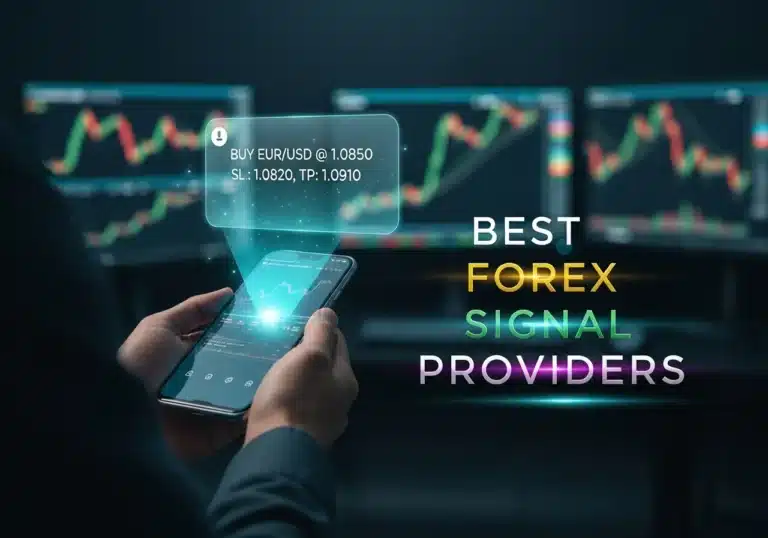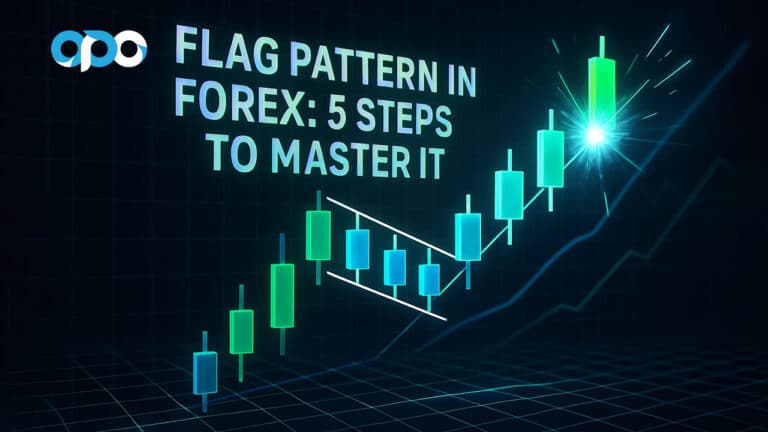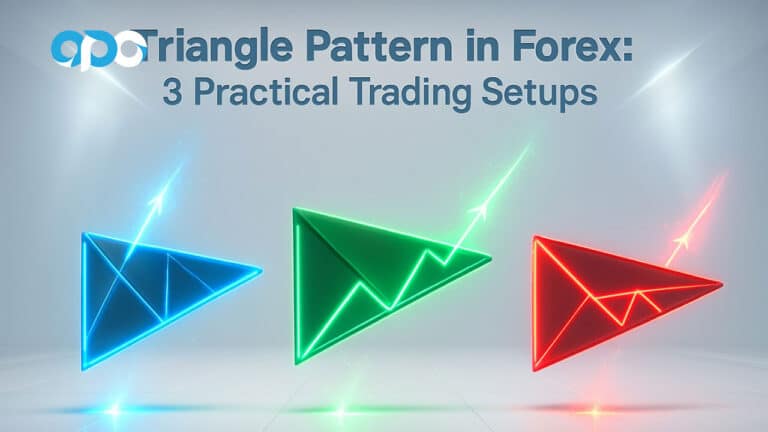The best smart money indicator is widely considered to be the Smart Money Concepts [LuxAlgo] due to its comprehensive, all-in-one toolkit that visualizes all core SMC principles on your chart. However, the “best” tool ultimately depends on your specific trading strategy and preferences. For traders seeking a reliable online forex broker to apply these concepts, finding one with robust platforms is key. This guide will break down the top 5 indicators, including free options, and detail a practical strategy on how to use a smart money indicator effectively to identify high-probability setups.

Key Takeaways:
- What Makes a Good SMC Indicator: The best smart money indicator should clearly identify market structure (BOS/CHoCH), order blocks, fair value gaps (FVGs), liquidity, and premium/discount zones.
- Top All-in-One Choice: The Smart Money Concepts [LuxAlgo] indicator is a top contender for its comprehensive features, making it a favorite for both new and experienced SMC traders.
- Strategy Over Tools: An indicator is a visualization tool. Success comes from understanding the underlying Smart Money Concepts strategy, not from blindly following signals.
- Confluence is Crucial: The most effective trading decisions are made when multiple SMC signals align on your chart, such as an order block appearing in a discount zone after a liquidity grab.
- Free Options Exist: While premium indicators offer more features, there are effective and free smart money indicator TradingView options available for those on a budget.
What Are Smart Money Concepts (SMC)?
Before we dive into the tools, let’s have a quick refresher. Smart Money Concepts (SMC) is a trading methodology based on the idea of tracking the footprints of “smart money”—institutional players like banks, hedge funds, and large financial institutions. These entities move vast amounts of capital, and their actions create predictable patterns on the chart. Unlike traditional retail indicators like the RSI or MACD, which often lag, SMC focuses on the cause of price movement: liquidity and order flow. Think of it like this: retail traders are often like a school of fish, reacting to price movements. Smart money is the whale, causing the movements the fish react to. The goal of an SMC trader is to swim with the whale, not the fish.
Core Parts of a Great SMC Indicator
When searching for the best smart money indicator, you’re not just looking for a tool that flashes “buy” or “sell.” You’re looking for an assistant that can accurately and automatically map the core elements of SMC onto your chart. From my experience, a top-tier indicator must have these components to be truly effective and save you hours of manual charting.
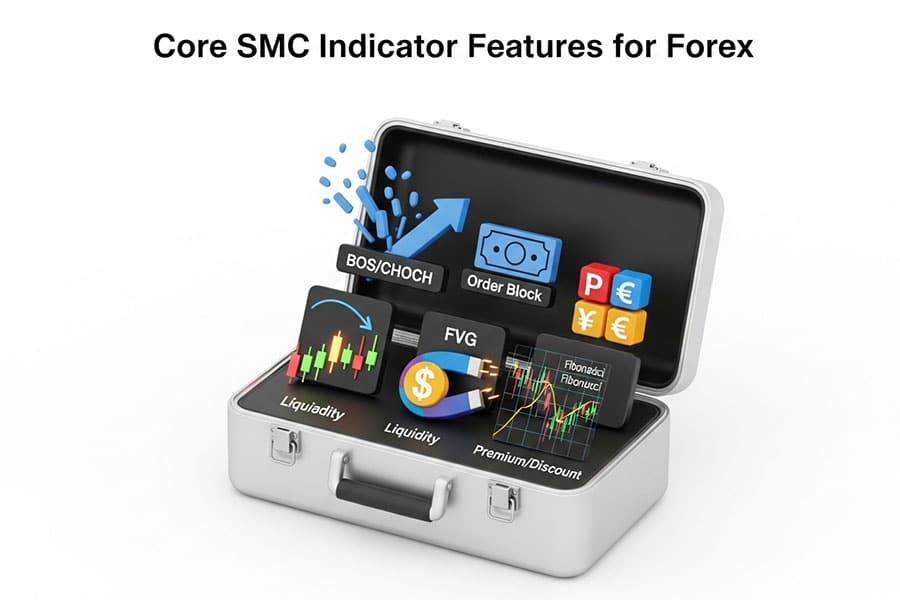
Market Structure Mapping
This is the absolute foundation. The indicator must automatically identify and label key structural points. This includes a Break of Structure (BOS), which confirms the continuation of a trend, and a Change of Character (CHoCH), which signals a potential trend reversal. A clear visual representation of these points is non-negotiable.
Order Blocks
An order block is the last down-candle before a strong bullish move (or the last up-candle before a strong bearish move). These zones are where institutions have likely placed a significant cluster of orders. A great indicator will highlight these zones clearly, often color-coding them as bullish or bearish, so you know exactly where price might react in the future.
Fair Value Gaps (FVG) / Imbalances
When price moves aggressively in one direction, it can leave behind an inefficient gap known as a Fair Value Gap or imbalance. These are magnets for price. The market tends to revisit these areas to “rebalance” the price action. The indicator should instantly spot and display these gaps on your chart.
Liquidity Levels
Smart money hunts for liquidity. This liquidity rests above old highs (buy-side) and below old lows (sell-side). An effective smart money concepts indicator will automatically highlight these key liquidity zones, such as equal highs and lows, showing you where a “liquidity grab” or “stop hunt” is likely to occur.
Premium & Discount Zones
Professionals buy at a discount and sell at a premium. A premium/discount tool, often a Fibonacci-based overlay, divides a price range into two zones. In a downtrend, you want to look for short entries in the premium (upper) zone. In an uptrend, you look for long entries in the discount (lower) zone. The best tools have this built-in.
Read More: Best Order Block and FVG Indicator
The 5 Best Smart Money Indicators
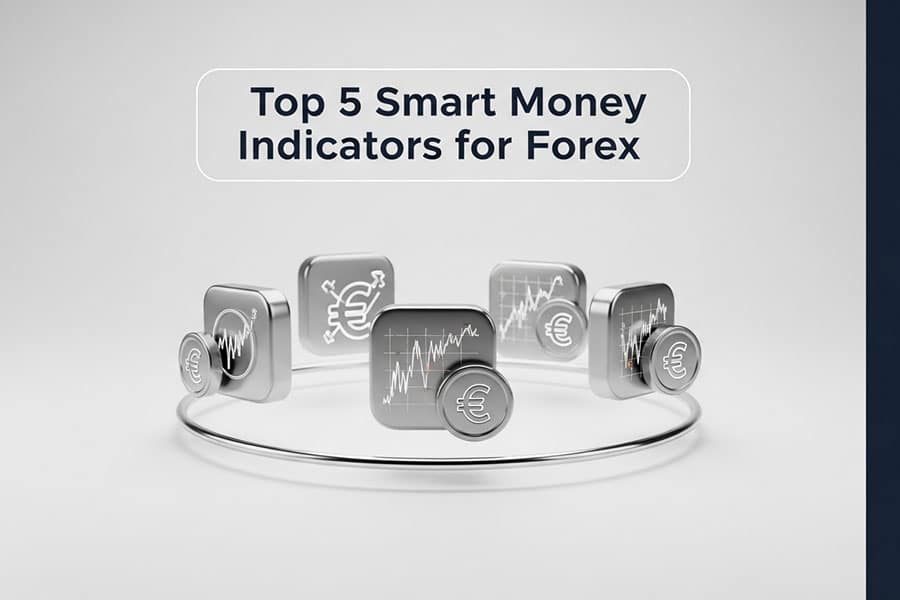
Now, let’s get to the core of the matter. After testing dozens of tools, I’ve narrowed down the top five contenders. Each has its own strengths, and I’ll explain who each one is best suited for. This list will help you find the best smart money indicator for your specific needs.
Smart Money Concepts [LuxAlgo]
- Platform: TradingView
- Best For: All-in-one analysis and traders who want the industry standard.
- Key Features: This is arguably the most popular and comprehensive smart money concepts indicator available. It includes internal and swing structure labeling (BOS/CHoCH), order blocks with mitigation signals, fair value gaps, premium/discount zones, and customizable liquidity level detection. It’s an entire SMC toolkit in a single indicator.
- Pros & Cons: The biggest pro is that it has everything you need, and it’s highly customizable. The only con is that the sheer number of features can be overwhelming for absolute beginners who haven’t yet learned the core concepts.
- Pricing: Premium.
Market Structure & Trends [Chart Prime]
- Platform: TradingView
- Best For: Traders who prioritize trend and market structure identification.
- Key Features: While LuxAlgo is an all-in-one SMC suite, this indicator from Chart Prime excels specifically at identifying trends and market structure. It provides excellent automatic trend lines, break of structure signals, and reversal signals. Its “Trend Strength” visualization is particularly useful for gauging the momentum behind a move.
- Pros & Cons: It’s incredibly clean and visually intuitive, making it great for focusing on the trend. However, it’s not as feature-rich in other SMC areas like order blocks or FVGs compared to LuxAlgo’s dedicated SMC indicator.
- Pricing: Premium.
Support and Resistance Power Channel [Chart Prime]
- Platform: TradingView
- Best For: Identifying dynamic zones of supply and demand.
- Key Features: This is a unique take on SMC. Instead of just plotting static order blocks, this indicator creates dynamic channels based on buying and selling pressure. It helps you visualize where control is shifting between buyers and sellers in real-time. It’s a powerful tool for confluence, confirming entries within established SMC zones.
- Pros & Cons: Its dynamic nature provides a forward-looking perspective that static levels can’t. The downside is that it’s less of a pure SMC tool and more of a complementary indicator. I wouldn’t use it as my only smart money indicator but rather in conjunction with another.
- Pricing: Premium.
ICP Liquidity [sonarlab]
- Platform: TradingView
- Best For: Traders specializing in liquidity grabs and stop hunts. This is a fantastic free smart money indicator TradingView users can access.
- Key Features: This indicator’s primary focus is on one thing: liquidity. It excels at plotting equal highs/lows, swing highs/lows, and other key liquidity pools. It’s designed to show you exactly where the market is likely to reach before reversing, which is the core of many advanced SMC strategies.
- Pros & Cons: It’s simple, free, and does its one job exceptionally well. If you’re struggling to identify liquidity, this is a must-try. The obvious con is its specialization; you will need other indicators for order blocks and market structure.
- Pricing: Free.
Inversion Fair Value Gaps [LuxAlgo]
- Platform: TradingView
- Best For: Advanced traders looking for high-probability reversal entries.
- Key Features: This indicator visualizes a powerful concept. An Inversion FVG is a fair value gap that fails to hold and gets broken through. When price returns to this “inverted” level, it often acts as strong support or resistance. It’s a sign of trapped traders and provides a very clean entry point for reversals.
- Pros & Cons: It identifies a very specific, high-probability setup that many other indicators miss. This can give you a real edge. However, it’s an advanced concept, and setups are less frequent, so it’s best used as part of a broader SMC strategy.
- Pricing: Premium.
Read More: Unlock the Power of Institutional Order Flow
How to Use a Smart Money Indicator
Having the best smart money indicator is useless if you don’t have a solid strategy. An indicator doesn’t trade for you; it clarifies the chart so you can execute your strategy more effectively. Here is a simple, step-by-step framework I personally use. This is how to use a smart money indicator to find and execute a trade.
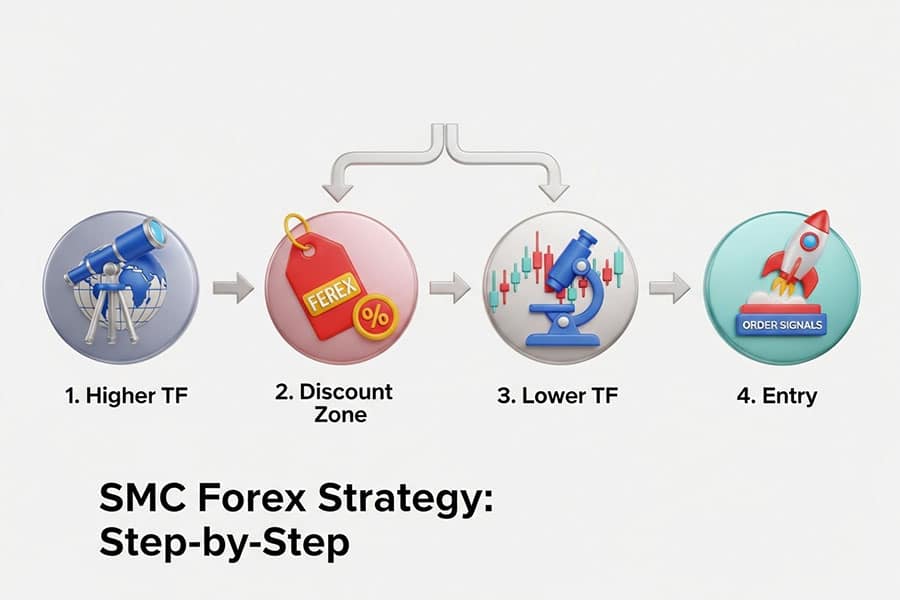
Step 1: Find the Higher Timeframe Trend
All great trades start with a top-down analysis. Before you even think about an entry, you need to know the overall market direction. I’ll start on the 4-hour or daily chart. Is the indicator printing higher highs and higher lows with consistent Breaks of Structure (BOS) to the upside? If so, the trend is bullish, and I should only be looking for buy setups. If it’s the opposite, I’m looking for sells. This step alone will keep you out of so many bad trades.
Step 2: Wait for a Retracement to a Key Level
Once I’ve established the higher timeframe trend (let’s say it’s bullish), I will not chase the price. Chasing is a retail mistake. Instead, I wait patiently for the price to pull back into a “discount” zone. I use the indicator’s premium/discount tool for this. Within that discount zone, I’m looking for a Point of Interest (POI), which is typically a clean, unmitigated Order Block or a significant Fair Value Gap (FVG).
Step 3: Look for Lower Timeframe Confirmation
This is where patience pays off. Once the price taps into my higher timeframe POI (the order block or FVG in the discount zone), I drop down to a lower timeframe, like the 15-minute or 5-minute chart. I am now waiting for confirmation that smart money is stepping in. The signal I’m looking for is a Change of Character (CHoCH). This means the lower timeframe trend, which was bearish during the pullback, is now breaking its structure to the upside. This is my entry trigger.
Step 4: Set Your Stop Loss & Take Profit
Risk management is everything. Once I see the lower timeframe CHoCH, I can plan my entry. My entry will be on the small order block that caused the CHoCH. My stop loss goes just below the low of that small structure. For my take profit, I look back at the higher timeframe chart and target the next major liquidity pool, which is usually the previous high that was formed before the pullback began. This approach ensures a positive risk-to-reward ratio.
Best Settings for SMC Indicators
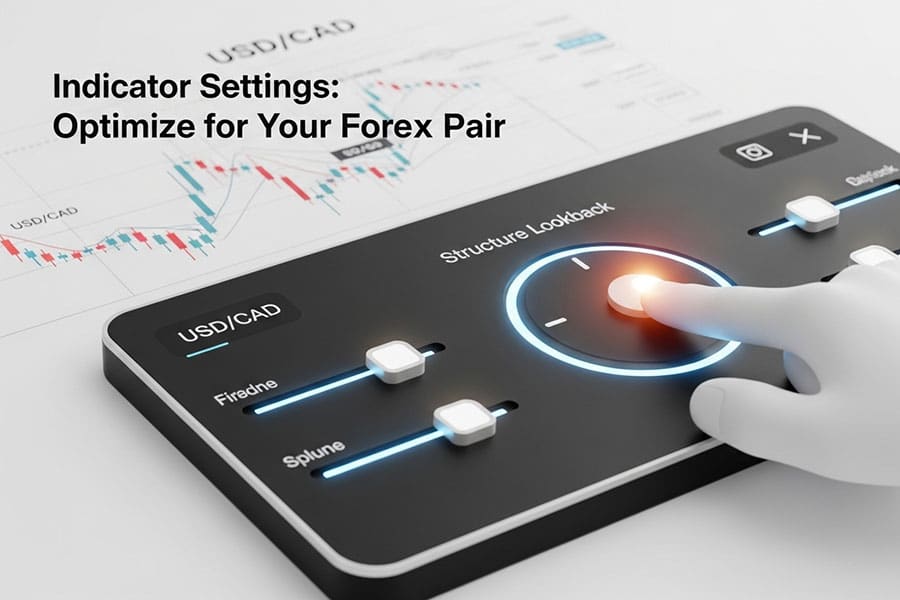
A common question is about the “best” settings for a smart money concepts indicator. The honest answer is that it depends on your trading style and the asset you’re trading. A scalper on the 1-minute chart will need more sensitive settings than a swing trader on the daily chart. However, I can give you a solid baseline to start with for an all-in-one indicator like the LuxAlgo SMC.
For a swing or intraday trader on the 15-minute to 4-hour charts, I’d recommend starting with the default settings for most features like order blocks and FVGs. They are often optimized for general use. The key setting to tweak is the “Market Structure Lookback” or similar. A longer lookback period (e.g., 20-30) will identify more significant, higher-level structure points, while a shorter lookback (e.g., 10-15) will show more internal, minor structure.
Pro Tip: Don’t just copy someone else’s settings. Open your chart, apply the indicator, and go back in time. Manually identify what you would consider a valid BOS or CHoCH. Then, adjust the indicator’s settings until its automatic labels align with what your own strategic eye sees. Backtest these settings to ensure they are profitable for your system. The goal is to make the tool work for your strategy, not the other way around.
Read More: The Smart Money Concept
Common Mistakes to Avoid with SMC
Using a powerful tool like the best smart money indicator can give you a significant edge, but it can also lead to new kinds of mistakes if you’re not careful. From my experience coaching traders, a few pitfalls come up repeatedly. Avoiding these is just as important as learning the entry strategy.
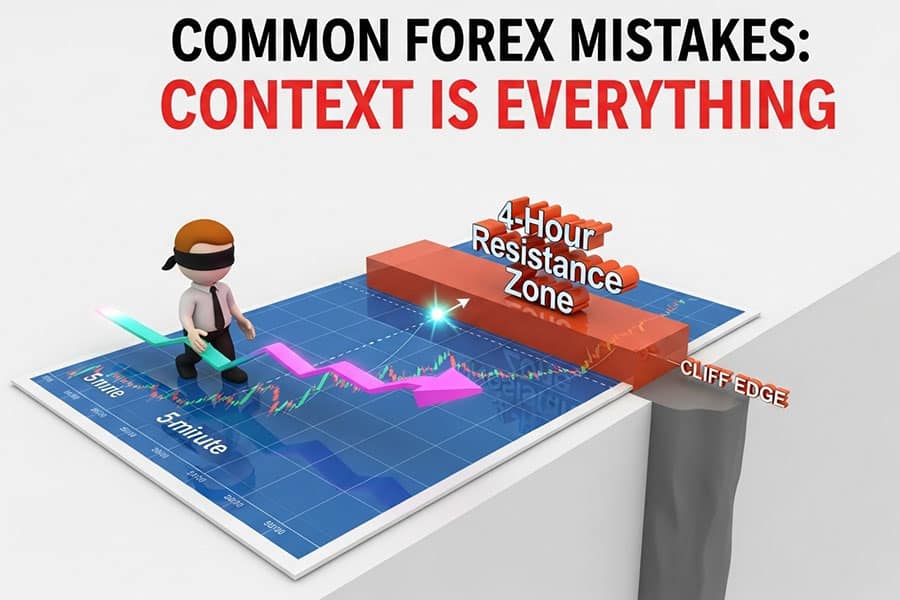
The first and most common mistake is blindly following signals without context. An indicator might label a perfect-looking order block, but if it’s sitting in the middle of a range, against the higher timeframe trend, and with no major liquidity taken, it’s a low-probability setup. Always ask “why” this setup is here. The indicator is the “what,” your brain provides the “why.”
Another major error is ignoring higher timeframe analysis. A trader might find a beautiful CHoCH on the 5-minute chart for a long entry, only to get run over because the price just hit a major 4-hour supply zone. The higher timeframe always has seniority. Your lower timeframe entry must be in harmony with the larger market narrative.
Finally, even with the best smart money indicator in the world, poor risk management will bankrupt you. Traders get so confident in an SMC setup that they risk too much on one trade. They fail to define their stop loss before entering or widen it when the trade goes against them. Remember, even A+ setups can fail. Your job is not to win every trade but to manage risk so that your winners are bigger than your losers over time.
Opofinance Services
To effectively apply the strategies discussed, pairing the best smart money indicator with a capable broker is essential. Opofinance, an ASIC-regulated broker, offers a robust environment for traders looking to leverage advanced tools and concepts.
- Advanced Trading Platforms: Trade on industry-leading platforms including MT4, MT5, cTrader, and their proprietary OpoTrade.
- Innovative AI Tools: Gain an edge with exclusive AI-powered tools such as the AI Market Analyzer, AI Coach, and AI-driven support.
- Flexible Trading Options: Explore opportunities in Social Trading and Prop Trading to diversify your strategies.
- Secure & Convenient Transactions: Benefit from safe and flexible deposit and withdrawal methods, including crypto payments, with zero fees charged by Opofinance.
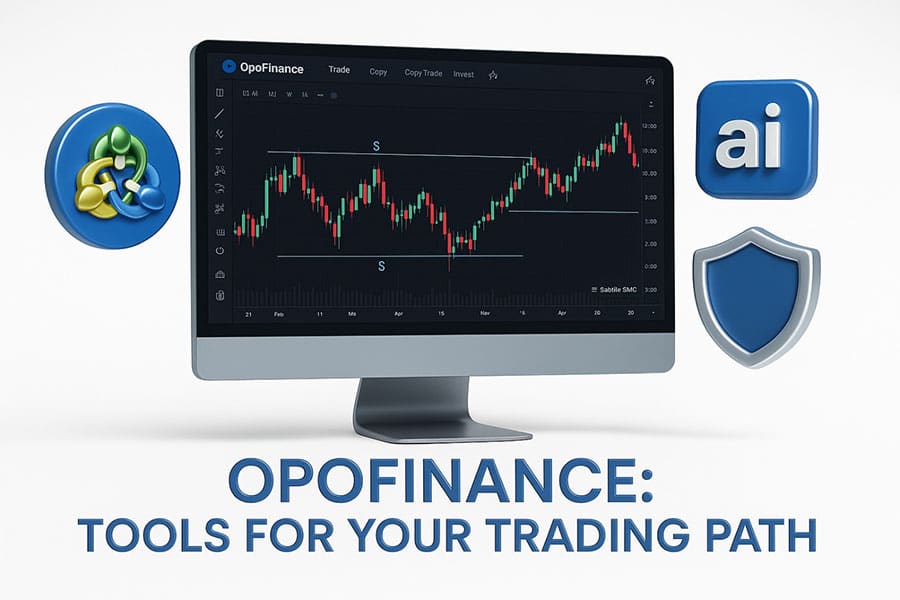
Enhance your trading experience by combining powerful indicators with a technologically advanced broker. Explore what Opofinance has to offer today.
Conclusion
Choosing the best smart money indicator comes down to aligning a tool’s strengths with your trading strategy. While LuxAlgo’s SMC indicator stands out as a powerful all-in-one solution, the best choice is one that clarifies the chart for you, rather than cluttering it. Remember, the indicator is just a lens. True success in trading Smart Money Concepts comes from mastering the strategy, practicing patience, and executing with disciplined risk management. The goal is to use these tools to refine your view of market structure, liquidity, and order flow, enabling you to make higher-probability trading decisions consistently. This is how you find your own best smart money indicator.
Can SMC indicators predict market crashes?
No indicator can “predict” events like market crashes with certainty. However, a smart money indicator can show you signs of large-scale distribution (smart money selling off positions) on higher timeframes, which can act as an early warning of significant downside potential.
Are there SMC indicators for MT4/MT5?
Yes, while TradingView has the largest selection, many developers have created smart money concept indicators for MetaTrader 4 and 5. You can find them on the MQL5 marketplace or through independent vendors. Their functionality can vary, so always check reviews.
Do I need multiple SMC indicators at once?
It’s generally not recommended. The best smart money indicator is often an all-in-one suite. Using too many indicators on your chart can lead to “analysis paralysis” and conflicting signals. It’s better to master one comprehensive tool.
How much do premium SMC indicators cost?
Prices vary widely. A premium subscription for a high-quality smart money concepts indicator on TradingView typically ranges from $30 to $100 per month, with some offering lifetime access deals.
Can I use a smart money indicator on a mobile device?
Yes, if the indicator is for TradingView, you can view it on the TradingView mobile app. However, performing detailed analysis and executing trades is almost always more effective and less error-prone on a desktop or laptop with a larger screen.





